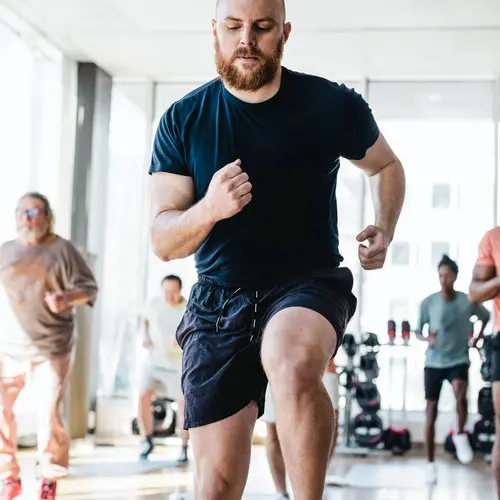How It Works
Whether you've done yoga for a long time or are a dedicated gym-goer looking for ways to refresh your usual workout, yoga fusion is a great place to start.
Yoga fusion is a trend that blends yoga poses with other fitness regimens, such as Pilates, strength training, dance, or even kickboxing.
Pairing yoga with other disciplines lets you burn more calories than yoga alone, while still getting the benefits of this ancient practice.
A 150-pound person burns about 240 calories an hour doing yoga, compared to about 360 calories for an hour of aerobics. By bringing together cardio exercise and yoga, you get the best of both worlds.
Although yoga comes in various styles, they all offer potential health benefits, including stress reduction and better flexibility, and they may help manage chronic conditions such as heart disease and high blood pressure.
By melding yoga into other workouts, you can bring its stress-busting benefits and mindfulness to your exercise routine.
Intensity Level: Medium
It depends on what type of yoga is blended with other disciplines. In many cases, the workouts are more intense than doing yoga alone.
Areas It Targets
Core. Yes. Many yoga poses engage your core to help you hold the same position. When paired with Pilates, which is a core-focused routine, it provides even more benefits to your midsection.
Arms. Yes. Some types of yoga, such as power and ashtanga, have more demanding poses such as forearm stands, but incorporating hatha yoga into most workouts will still offer poses that use your arms.
Legs. Yes. You use your leg muscles in many yoga poses.
Glutes. Yes. Some fusion classes, like yoga and kickboxing, include exercises that tone your glutes. Others that include dance or Pilates use your glutes to do the moves.
Back. Yes. You use your back muscles in many yoga and exercise routines. Yoga may also help with your back alignment.
Type
Flexibility. Yes. Any type of yoga helps your flexibility.
Aerobic. No. Some yoga fusions are aerobic workouts, but not all.
Strength. Yes. In yoga, you use your own body weight to build strength. Fusing yoga with other workouts may give you even more strength training.
Sport. No.
Low-Impact. Yes. Most yoga fusion routines are not based on high-impact exercises, although there are some exceptions.
What Else Should I Know?
Cost. Varies. Yoga fusion classes are available at many gyms and yoga studios, or workouts are available online or via app.
Good for beginners? Yes.
Outdoors. Yes, you can do some yoga fusion workouts outdoors.
At home Yes.
Equipment required? No.
What Dr. Melinda Ratini Says:
There are many types of yoga fusion, so you are sure to find one that suits you.
These classes are ideal if you have taken yoga and are looking to ramp up your workout to include more cardio and strength training. It also offers great benefits if you are in great shape but would like to add a mind-body connection to your workout.
Yoga fusion is a great workout that can help you build muscle and stamina while teaching you to relax and focus. You can do it alone or in a group with an instructor.
It's not for you if you like a fast-moving, hard-driving workout unless you are ready to take the next step toward a more holistic approach to mind and body strength.
Is It Good for Me If I Have a Health Condition?
Yoga fusion is a great activity to consider, in most cases.
The postures of traditional yoga add a mind-body awareness to the aerobic workout that you need to help reach an ideal weight and build stamina.
If you have diabetes, it can help to bring your blood sugars under control while lowering your blood pressure and “bad” LDL cholesterol. This cuts your chances of getting heart disease and other chronic illnesses.
If you have high blood pressure, diabetes, or trouble with your heart, you may need to avoid certain poses, like those where your feet are above your head or require balance that's beyond what you can do. Talk to your instructor before class about any modifications you need.
If you already have heart disease or other medical problems, talk to your doctor first. You may need to start with a very gentle program of yoga coupled with a light aerobic activity like walking or swimming before trying a yoga fusion class.
Arthritis or problems with your knees and back do not have to keep you from practicing yoga fusion. Ask your doctor or physical therapist first to see if you have any restrictions.
Yoga fusion can help keep your joints flexible and build strength. Shop around for a class that fits your needs.
If you're pregnant, yoga fusion can be a great way to keep yourself and your baby healthy. If you took classes before you became pregnant, you should be able to continue. Your doctor can confirm that.
You'll need to change some positions and movements to accommodate your growing belly and your changing center of gravity. An experienced instructor can show you alternatives to lying on your back during the second and third trimesters and how to bend from the hips rather than the waist.
An added benefit of yoga fusion is that the breathing and relaxation techniques will also come in very handy during labor. The boost you'll get in flexibility and endurance is sure to help, as well.


